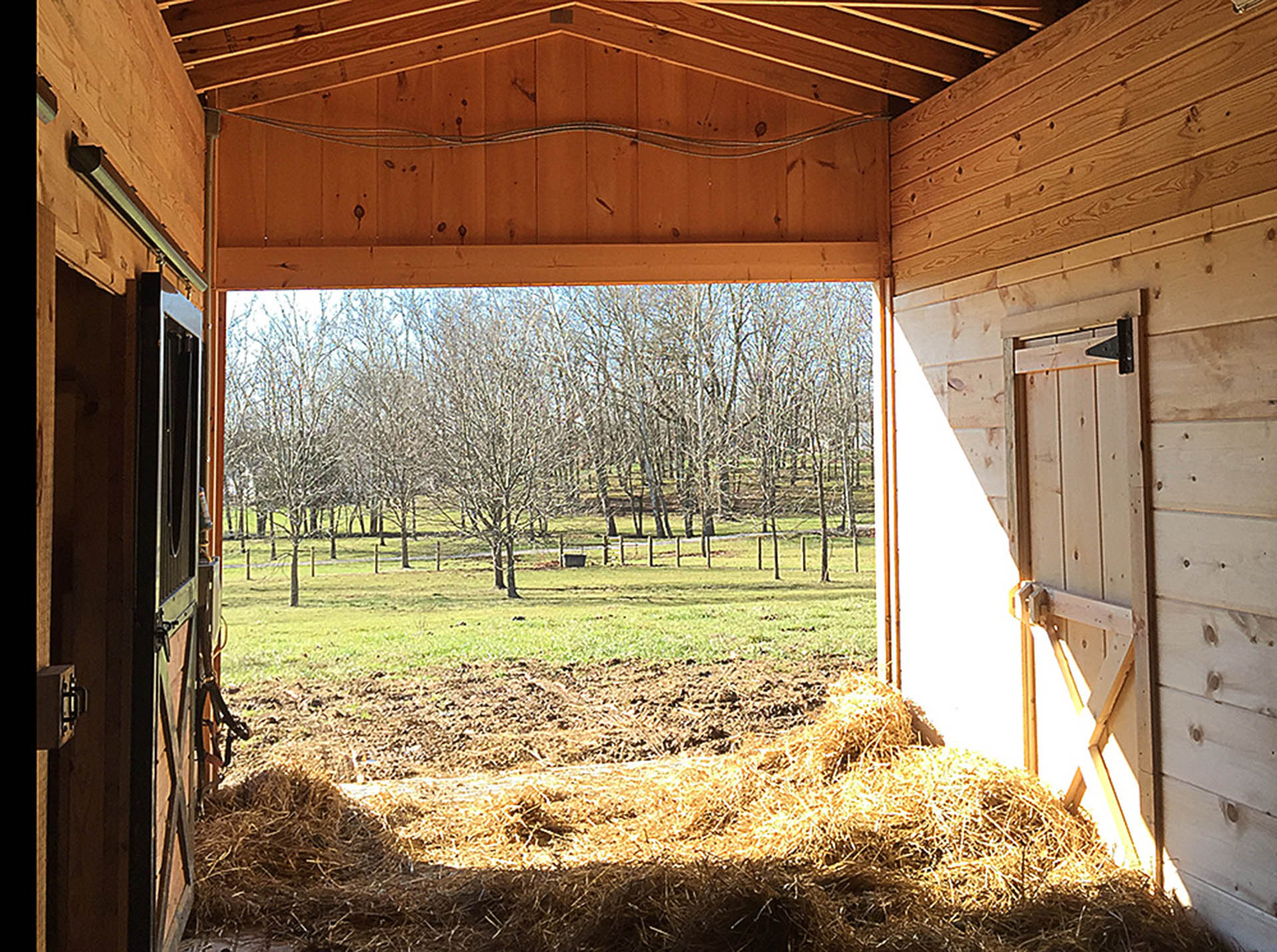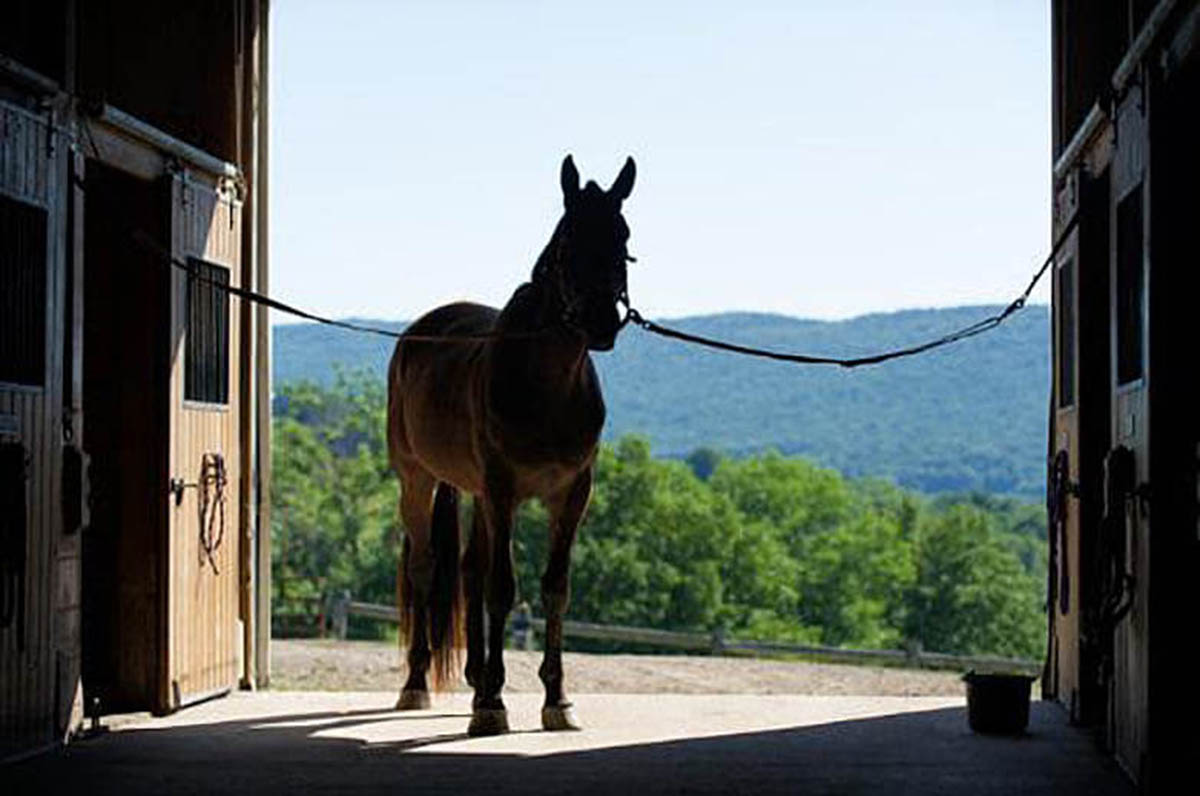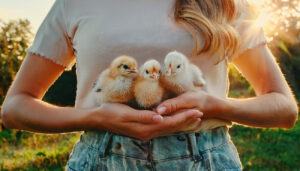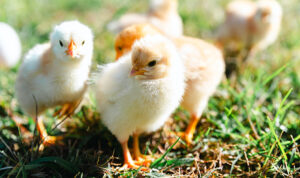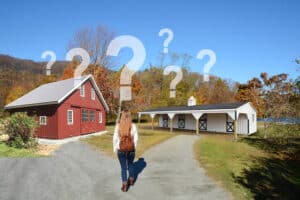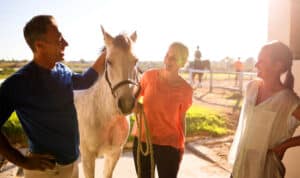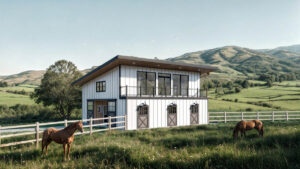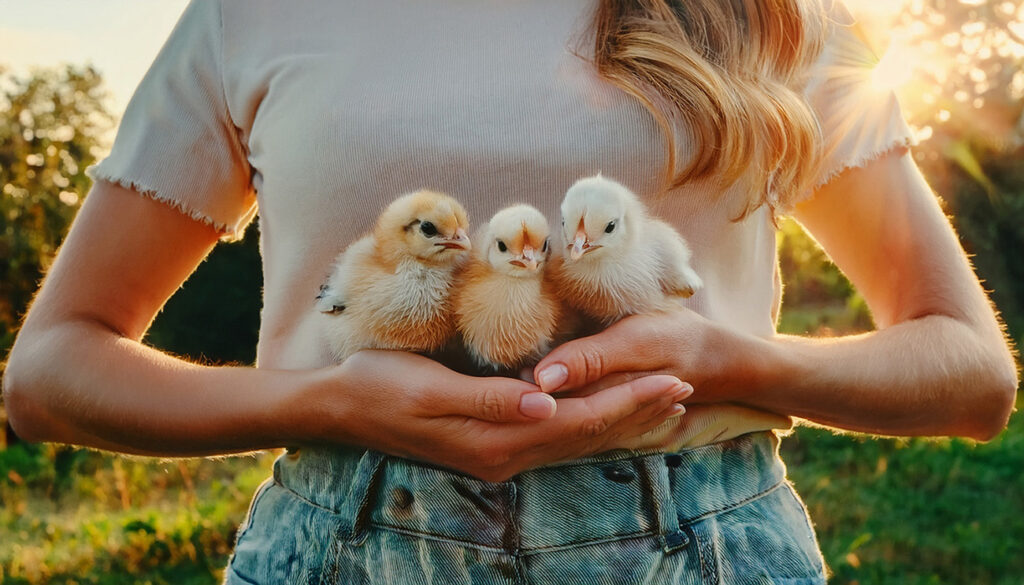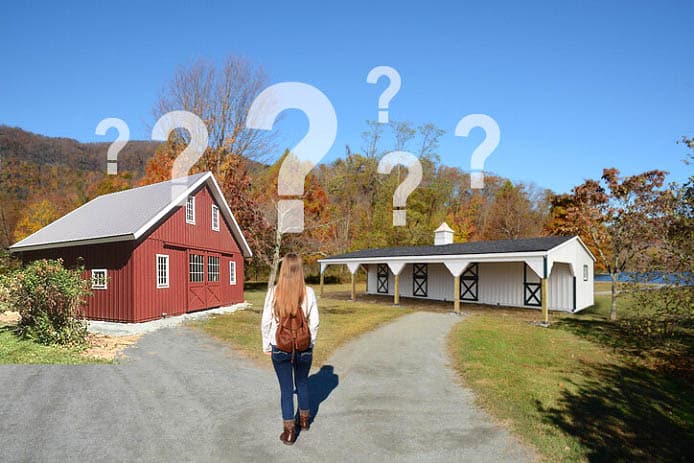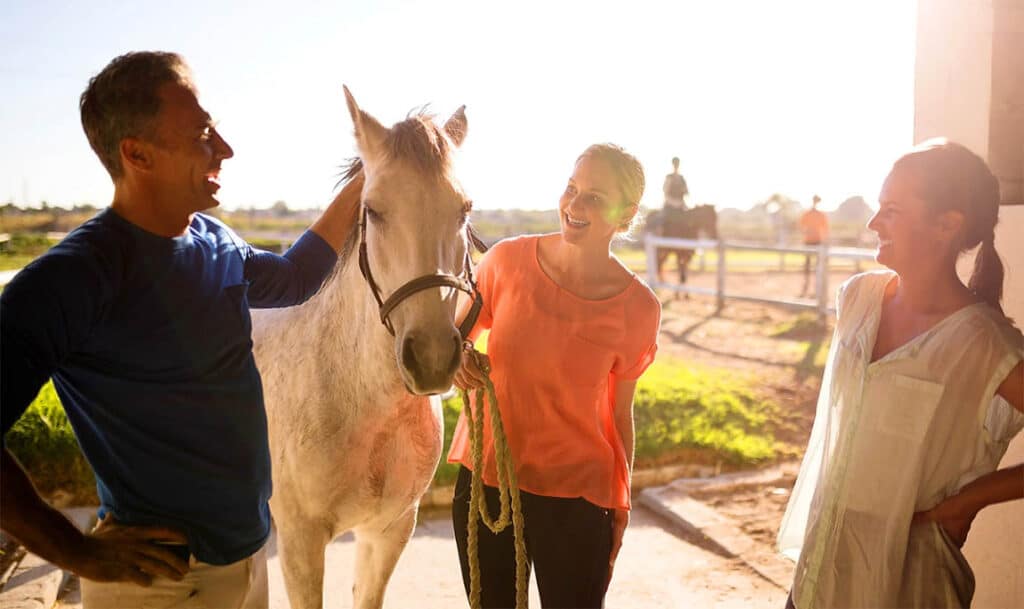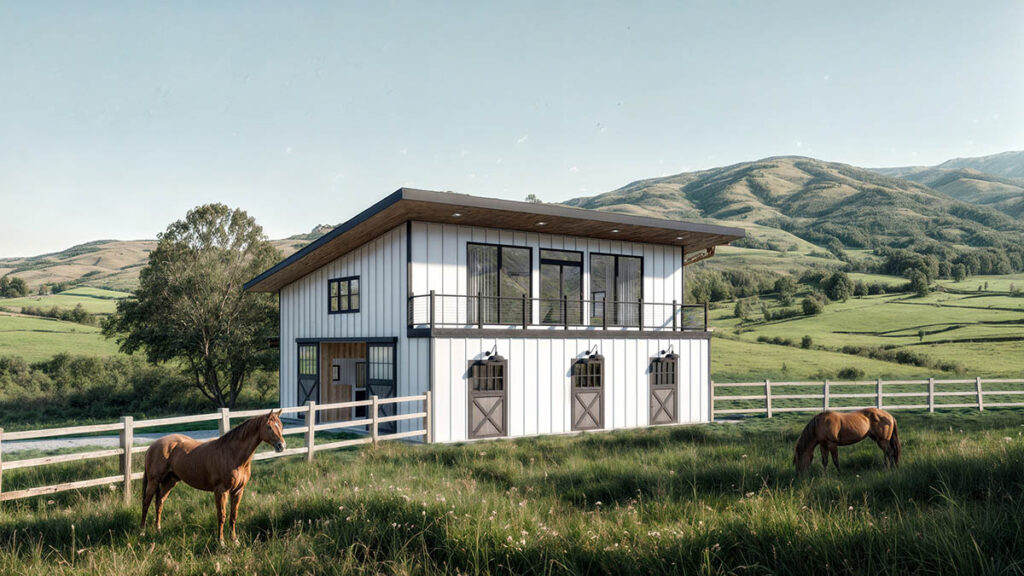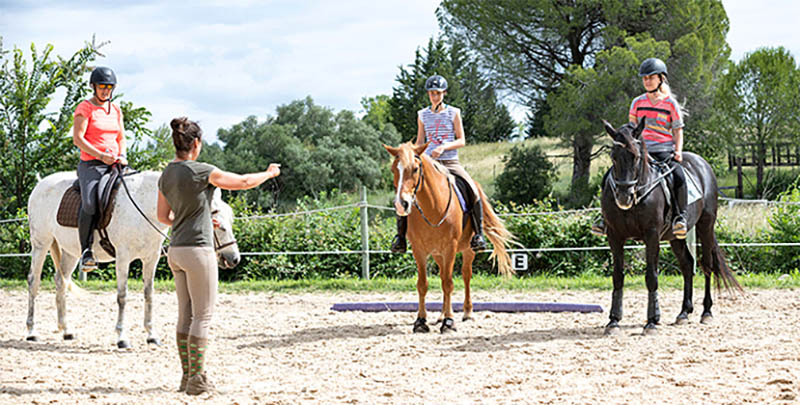The day has finally arrived and your new horse barn is ready to use. The smell of fresh shavings, the aroma of new wood and the promise of many happy hours to come in the company of your favorite equines is on the horizon.
Before you invite your wee equine beasties inside there are a few finishing touches to consider. Follow these simple horse barn designs to increase barn safety, functionality and utility:
Seal the Surfaces
Before your horse poops against the clean wall or scrapes his teeth on the kickboards it is a good idea to seal the walls with a horse-safe product. This will facilitate easier cleaning and promote hygiene when you need to disinfect or clean stalls later.
Safety Front and Center
Horse barn safety is one of the most crucial things to consider when managing the space where your horses reside. If you have an aisle barn think “safety first” when using the valuable center space. If the floor is dirt, adding shavings may look pretty but can create a fire hazard. Additionally, small, dropped items quickly disappear. Horseshoe nails, hoof picks, keys etc. Buried in shavings or hay, these items can easily be stepped on by horse or human with painful results.
A dirt center aisle will quickly become messy and hard to tidy up when haying your horses. Think about adding some stone dust and having it compacted for best results. Sweeping and raking becomes easier!
A textured cement center aisle is the easiest to maintain and keep clean. The aisle can then be swept or vacuumed clean. Hose it down without creating a muddy mess!
Regardless of your center aisle surface, adding rubber mats has many benefits:
- Prevents horses from slipping
- Reduces the effects of pawing by inpatient, cross-tied horses
- Easier on the legs and feet when horses are standing for vet/farrier/grooming
For a shedrow style horse barn design the addition of a gravel base with a stone dust top layer that slopes away from the building is a must in high traffic areas around the building. Extend the gravel/stone dust base to create a 1’ border around the barn perimeter. This improves drainage and helps reduce mud issues in high-traffic areas. Having this in place from Day 1 takes care of the problem BEFORE it occurs.
If you have followed the site preparation guidelines from Horizon Structures correctly, then you’ll already have an “apron” around your building for drainage. Be aware that large angular gravel may become trapped in the hooves of your horses especially if they are shod. It is wise to add a compacted stone dust layer to provide a safe footing and to protect from stone bruises.
Cross Ties
The use of cross ties in a center aisle barn is very popular in America. In Britain, where I grew up, horses are tethered to a ring on the back wall of their stall for grooming. On arrival in the USA, I found ties spanning the center aisle unconventional. What I have learned is that no matter acclimated to cross ties your horse may appear to be, cross ties can wreak havoc in a second.
Horses can spook or back up then panic at the cross tie contact, charge through and become entangled. Other horses can get loose in the barn and plow through the ties – with an innocent equine “by-stander” attached – with similar disastrous results.
I knew a clinic student who had her finger ripped from her hand while the farrier was working on her warmblood’s feet. The horse panicked and she instinctively reached for the emergency clip which resulted in the grievous injury! I have seen horses hit in the head when they pulled away from the tie and the metal clip snapped them on the forehead causing injury, horses running free with their legs tangled in nylon straps etc. PLEASE use cross ties wisely!
It is imperative that the cross ties are set high enough on the wall for the specific horses that use them and that they are securely attached to the wall or post. The ties should have emergency clips where they attach to the halter.
When tying horses, it is a good idea to use baling twine where the halter meets the cross tie clip so that if a panic situation arises the twine will break. NEVER attach a cross tie to a bit ring on a bridle.
My personal favorite design of cross tie is one that has a quick release snap at both ends, and has a 3 strap velcro connection about a foot from the horse end of the line. This horse barn safety feature will not only give way in an emergency, but the horse will not have a trailing piece of cross-tie to tangle in his legs if he takes flight. On a side note, for the same reason the 3 strap velcro is my favorite type of side rein when training horses to lunge.
Signage
At a minimum you should post the following signage:
- Inherent Risk Law for your State
- Requirement to wear head protection for riders when mounted
- Emergency contact lists for:
- Fire/police/EMT
- Vet
- Farrier
- Emergency treatment protocols for choking/heart attack etc.
It is important that you have phone access from your barn to emergency services. If you do not have reliable cell service at your barn, the addition of a land line may be old-fashioned but it is a prudent horse barn safety measure to take.
Other signs that are particularly useful for boarding barns are:
- Small dry-erase memo boards or index cards on stall doors for feeding/supplement/medication or turn out instructions
- Signs for general “house-keeping” guidelines: aisle way floor be swept clean, hoses be rolled up or put away after use, etc.
- Large white board, blackboard or bulletin board to leave notes, barn rule notices, calendar, etc.
Don’t forget EXIT signs! These should be lit and placed above each exit. Exit signs are required by law in some instances especially in public/commercial buildings.
First Aid Kit
There should be a first aid kit(s) for horses and humans and both need to be easily accessible and clearly visible. Whether you are a backyard owner or a professional boarding entity this is of paramount importance.
Pre-packaged first aid kits are readily available both online and at many retail locations. Or, you can put one together yourself. Check out an excellent article detailing essential horse supplies for your barn’s first aid kit HERE.
Security
When horses are outside it is safe to lock the barn and this is particularly important if you store expensive tack items in the building that are not under a separate lock and key or security door system.
For peace of mind it is also beneficial to install a security camera system when finishing your new horse barn. These systems can be purchased relatively inexpensively and linked to your cell phone via an app so you can view your barn in real time when you are elsewhere.
Keeping Your Barn Cool
You may have planned ahead and added electrical outlets between each stall for easy accessibility for your vet when the need for a power source for diagnostic equipment arises or for your use for a horse vacuum, clippers etc.
Note: When you discussing your new horse barn project with Horizon Structures ask about our electrical packages. This will give you a head start on providing electrical service to your barn.
When summer arrives and you’d like to add fans for extra cooling for your stabled equines do not be tempted to buy a regular box fan from the local big box store and strap it to the front grill of the stall.
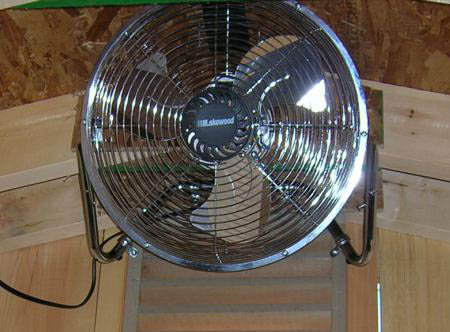
Keeping Your Barn Warm
My best advice is to keep the doors shut. Blanket your horses if needed. If you add a rocket heater or other flame heat source you are asking for trouble. The highly flammable environment of a horse barn is not a place to have any type of open flame. An electric heater such as an infra-red heater placed in an office or tack room as a place to warm up should only be used when you are present to monitor it.
Fly/Mosquito Systems
These systems can be very useful in areas of high fly and bug populations. Consult with a professional as to their use around horses especially where they are installed over stalls where hay and grain may be provided. You do not want your horse ingesting the repellents along with his food.
Sprinkler Systems
I’m sure we’d all like one of these in our barn but they are expensive and difficult to use in winter unless you have a heated barn. If you can afford it, go for it! Consult a professional who has experience working in an equine environment.
Fire Extinguishers
Obviously these are a must have and it is important they are properly maintained. For larger barns at a minimum place one by each entrance of the building. Having one in your tack/feed room is also a good idea.
Temporary Tack/Equipment Storage
A bridle hook to hang a halter and lead rope/bridle by each stall is very useful. Hooks should be blunt edged or rubber to ensure safety. When tacking up it is useful to have a collapsible saddle rack on the outside of a stall wall or a saddle-stand in the aisle way. Again the saddle stand should be blunt edged to avoid injury to horse or human.
For blankets the ideal situation is a tall wall-glide system that allows blankets to hang fully extended. However, not everyone has room for this luxury. Blanket bars can be fabricated out of plumbing pipe and mounted on stall doors. A rubber coated chain hooked onto the outside of the stall door works well, too.
Storage
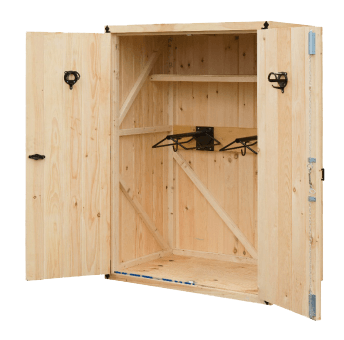
Horizon Structures offers built in saddle storage cupboards, tack storage boxes and feed bins so don’t forget to ask us about adding these to a storage space.
Medicines of any type should be stored at the right temperature and secured away from inquisitive children or pets.
Your barn is your happy place. Personalizing your new stable with finishing touches that offer safety and functionality can be just as satisfying as designing and planning the building itself. Have fun!


